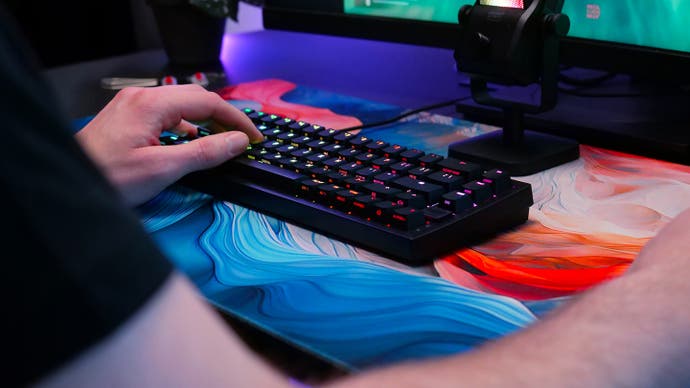Best 65% keyboards 2024: for gaming, typing and programming
The smallest mechanical keyboard size with arrow keys.
For me, 65 percent size keyboards are perfect. They straddle the line between compact and functional, with the arrow and navigational keys I rely on daily but without the cruft I don't, like the numpad or Function row. They're ideal for working on the go, often perfectly matched to the size of laptop keyboards, and provide tons of mousing space. Best of all, this form factor has seen an explosion of popularity, with even the biggest gaming brands exploring this brave new world once inhabited solely by mechanical keyboard enthusiasts.
It's a layout size that makes a lot of sense for a lot of people, which is why it's quickly become a staple of ranges offered by manufacturers big and small, and the mechanical keyboard boom of the last couple of years has only accelerated that process further.
Here are eight of our favourite 65 percent size mechanical keyboards, based on thousands of hours of building, testing, tweaking, gaming and typing over the past 15 years.
Simply choose a keyboard you like the sound of from the list below, or scroll on for our full recommendations - plus a quick FAQ section at the end! As always, if you have any questions or comments, then do let me know via the comments or the Twitter link at the end of the article, as I'm always keen to make these guides as useful as possible.
Best 65 percent keyboards for gaming, typing and programming
1. Cherry Xtrfy K5V2 CompactBrand new Cherry MX2A switches on a fully-featured keyboard, no software required |
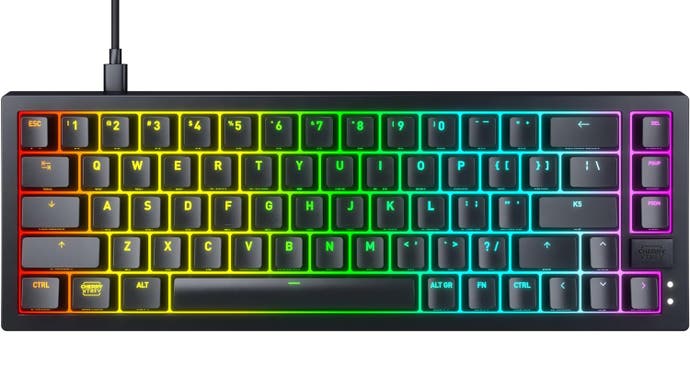
The Cherry Xtrfy K5V2 Compact is our new top 65 percent keyboard for 2024, as it's a compelling option that feels phenomenal for typing and gaming alike - and comes with bags of features without requiring any software at all.
The great key feel is down to the use of Cherry's own MX2A switches, which provide a much smoother, quieter and more uniform key press than the firm's venerable MX switch designs - which were beginning to be outpaced by third-party alternatives. We first saw these new MX2A switches on 2023's KC 200 MX, an office-focused board, but in a proper gaming design with soft touch ABS keycaps, pre-lubed stabilisers and a more durable case with layers of sound-dampening foam they feel even better: smooth, quiet and yet still with that precise mechanical feel. Strong RGB doesn't hurt either!
Interestingly, the board doesn't operate at the higher 2000Hz to 8000Hz polling rates offered by some competition-focused rivals, but boasts of a 2000Hz/0.5ms key scanning rate instead. I don't have the equipment to test the effect on latency, but it's an interesting move in a world where higher polling rates (and rapid trigger technology) are becoming increasingly common.
Xtrfy was formed from the legendary Ninjas in Pyjamas esports organisation, and as such their products tend to eschew software controls for tournament-legal adjustments on the device itself. That's the case here too, with almost every key coming with a secondary function. You can record and replay macros, control the mouse, alter the backlighting, adjust the volume and skip songs, access keys not physically present on the compact layout and much more besides. This is an awesome approach and I love that it's a viable option versus the Razer/Corsair software-first paradigm - which has its benefits but also loads up your PC with software that needs updating, takes up resources and occasionally misbehaves. With the K5V2, you get none of those downsides, which certainly appeals to me.
2. Corsair K60 Pro MiniA refined Corsair board with optical switches and sound dampening |
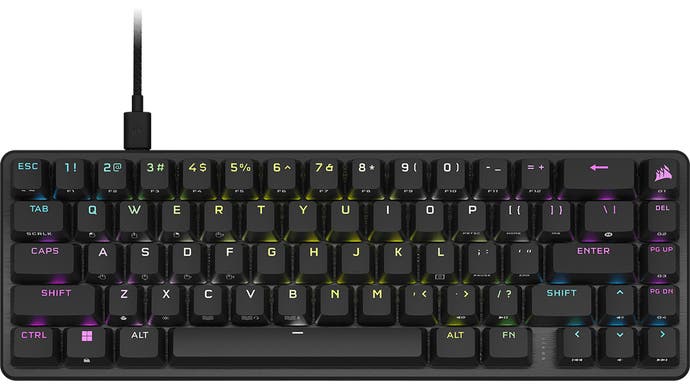
The 2023 Corsair K65 Pro Mini sounds like a follow-up to the 2021 K65 Mini, yet it uses a different form factor - 65 percent rather than 60 percent. Beyond the slightly larger layout, there's a clear through line between the two compact designs, with the new K65 Pro Mini opting for a lower-profile metal chassis and Corsair's OPX optical key switches for faster response times.
Like its predecessor, the K65 Pro Mini supports up to an 8000Hz polling rate via a detachable USB-C cable, with double-shot PBT keycaps and two layers of sound-dampening foam providing a luxurious typing feel. Corsair's iCUE software and RGB lighting in general is some of the best in the business, and with the range of Corsair's current product stack it's possible to coordinate lighting effects across a wide range of internal components and external peripherals.
The K65 Pro Mini is more expensive at debut than its K65 Mini predecessor, but no doubt we'll see it become more affordable over time - and you're certainly getting a superior typing and gaming experience here, thanks to the upgraded design, the inclusion of arrow keys and the new optical switches. Corsair aimed for a keyboard that feels great right out of the box, no modification required, and that's exactly what they've delivered.
3. Fnatic Streak 65 LPAn all-out gaming board that performs beautifully |

The Fnatic Streak 65 is our second-favourite 65 percent keyboard, offering all of the functionality you need for competitive games in a small, convenient form factor. The keyboard uses Fnatic's own silent, linear and low profile 'speed' mechanical switches, allowing extremely rapid key presses and making double-taps easier in shooters and action games. As well as not taking up much desk space, a 22mm height and 420g weight means that this keyboard will fit in a bag or even the front pocket of a hoodie easily. The compact dimensions and aluminium frame contribute to a very sturdy feel too.
Beyond the form factor, Fnatic have done well to nail the details here as well. The stabilisers on larger keys are pre-lubed for silent and easy operation, the USB-C port is offset to the left to ensure the cable doesn't interfere with your mouse and the legends on each keycap are inscribed with a legible, grown-up font. The switch housings are even transparent and two extra LEDs are embedded beneath the space bar to ensure that the customisable RGB lighting is evenly distributed throughout the board. I particularly liked the inclusion of a 'competition mode', which sets to the lighting to dim orange and locks the Windows key.
Fnatic has also released the more premium Streak 65 LP, which adds double-shot PBT keycaps, a coiled USB-C cable, sound-dampening foam and improved spacebar lighting. I'd say it's worth the extra money - but both options remain excellent choices.
4. Asus ROG FalchionA wealth of connectivity options and some fresh ideas |
|
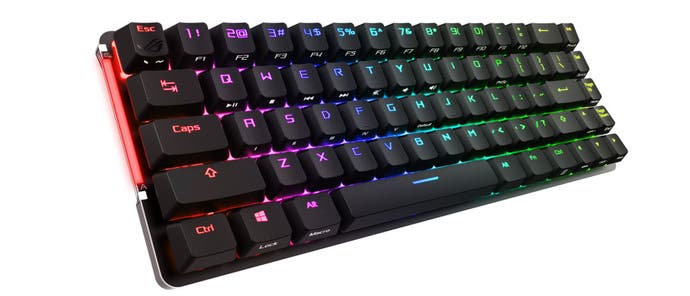
The Asus ROG Falchion is one of the more expensive boards on this list, but it looks, feels and acts the part with some unique features we haven't seen anywhere else.
There's a touch-sensitive strip on the left side of the board that you can stroke to adjust the volume, activate macros or other functions. The keyboard also comes in two pieces, with a plastic chassis sitting inside a removable metal-lined case, so you can opt for durability and key feel of the fully-assembled unit or a lighter, more portable keyboard. The Falchion can also be used wired, via USB, or wireless via a low latency 2.4GHz connection.
When you combine this deep feature list with what is in all other respects an excellent keyboard - strong build quality, good key feel from its Cherry MX Red switches, clear legends in its double-shot PBT keycaps, bright RGB backlighting and easy reprogramming - you get one of the most impressive keyboards we've ever tested.
Asus has also just released their low profile, wireless Falchion entry - the ROG Falchion RX Low Profile. It contains Asus' own low profile switches, which are pre-lubed, and feel especially smooth and snappy under finger. Up to 430 hours of runtime on its wireless USB receiver is good too, while there is also Bluetooth and wired USB-C connectivity, too, for a nice selection of options. It also looks sleek in its white colourway, and even comes with a keyboard cover for travelling.
5. Razer BlackWidow V3 Mini HyperSpeed Phantom EditionRazer's signature style plus low-latency wireless |

The BlackWidow V3 Mini offers Razer's HyperSpeed wireless in a 65 percent form factor, allowing the keyboard to connect over a low-latency 2.4GHz connection in addition to Bluetooth and wired USB-C. One nice touch here though is that you can connect a keyboard and mouse to the same USB dongle, but this tech only works with very recent Razer releases.
There are two Razer-made switches available: quiet linear (yellow) and clicky (green). The yellows are great for gaming and still good for typing, thanks to their quiet report and moderate travel. Razer's double-shot ABS keycaps feel great, with a bit of texture and cleanly inscribed legends. The aluminium frame also provides a feeling of rigidity; there's no deck flex evident in this keyboard whatsoever.
The V3 Mini Hyperspeed's incredibly long name becomes even longer with the Phantom Edition, which is actually pretty neat. With the backlighting disabled, the keyboard looks to have blank keycaps, but the legends appear when the RGB is turned on. This doesn't have any practical purpose, but it's just cool to look at - whether that's worth the extra money is up to you.
Battery life is good, at 200 hours unlit, but this drops to only 17 hours with constant lighting at its maximum brightness, and recharging takes five hours. However, you can get around 50 hours with a more moderate lighting setting, so getting a week of use between charges seems quite possible.
All things considered, the BlackWidow V3 Mini HyperSpeed is a great compact keyboard, especially now that's significantly cheaper than RRP. If you're already in Razer's extensive ecosystem, this is their best compact keyboard yet.
6. Epomaker TH66A handsome, quiet 65 percent keyboard with rotary encoder |

The Epomaker TH66 is an incredibly feature-rich and well-built keyboard given its entry-level price tag. The keyboard sports a rotary encoder (ie a metal volume wheel) in the upper right corner, a rarity for keyboards of this size, as well as full RGB backlighting, a range of Gateron switches, PBT keycaps, a 2200mAh battery and a choice of USB-C wired, Bluetooth or 2.4GHz wireless connectivity. It's a beautiful board right out of the box, and of course you're free to make it your own too, with hot swappable switches and a relatively standard layout that aids keycap swaps.
Inside, there are some interesting things going on too. This is one of the quietest keyboards I've used, thanks to a unique gasket structure, two layers of foam dampening and lubed stabilisers. Combined with my review board's soft clicky switches, and you've got a recipe for a crisp, satisfying report - without the rattle or ping of more typically constructed mechanical keyboards.
The software side of things is a bit more barebones, but it's easy enough to rebind keys, adjust the lighting, record macros and update the keyboard's firmware. The user manual is also worth reading, as you don't get any secondary functions listed on the default keycaps - so knowing how to press insert, delete or print screen is a matter of memorisation, although key combos like Fn + 1 being F1 are more obvious.
Altogether, it's impressive how much quality Epomaker has packed into a keyboard of this price point. If you like the layout and the features appeal, you won't be disappointed.
7. Roccat Vulcan 2 MiniA novel 'dual LED' keyboard with all the RGB |

The Roccat Vulcan 2 Mini and wireless Roccat Vulcan 2 Mini Air are some of the best-looking 65 percent keyboards on the market, thanks to their slimline anodised aluminium chassis, floating half-height keycaps and twin LEDs embedded in each switch. These LEDs are intelligently activated too, lighting up secondary functions to make them more readable and getting brighter when the Function key is activated.
This unique lighting has been used to full effect too, with a surfeit of secondary functions packed into the 65 percent design - including all the keys not included physically, plus media controls, profile switching, backlight adjustment and more. All of these can be customised via the Roccat Swarm software, which still requires way too many updates in my book and feels overly complicated - but it does work well enough once you've gotten to grips with it.
The keycaps are one of the few relative low points of the keyboard; their low profile design looks cool but the ABS plastic used here is extremely slippery under the finger. The Titan 2 optical linear switches beneath make up for this though, with soft but convincingly mechanical actuation and full compatibility with MX-style keycap replacements. The USB-C cable is also detachable, which we expect to see in this more portable form factor, which also allows for customisation.
If you prefer a wireless keyboard, the Air model provides this - albeit at a steep premium at the time of writing. I'd say that extra money is well spent, with both 2.4GHz and Bluetooth connectivity options and up to 240 hours of battery life thanks to a proximity sensor that dims the lighting when you're not using the keyboard, but most folks are probably best of with the wired model.
Altogether, a great 65 percent keyboard that should appeal to anyone that wants a compact design but doesn't want to sacrifice convenient access to a full keyset. Black and white colourways are available.
8. Royal Kludge RK68A clean and simple 65 percent board |
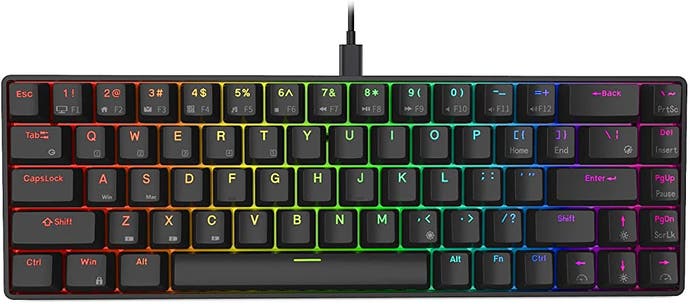
The RK68's selling point is simple: a quality compact mechanical keyboard at half of the price of the big brands. It costs around fifty currency units at the time of writing, yet feels great to type on with clicky, tactile or linear Gateron switches and full per-key RGB.
There's no software here to synchronise the lighting with other peripherals - such is the sacrifice you make by going for a smaller brand - but controls on the keyboard itself allow you to adjust the lighting easily enough. There are also no options for adjusting the angle of the board. I use my keyboards flat as this is meant to be ergonomically superior, but if you require more tilt than the ~5° provided by the keycaps and board itself you may need to look elsewhere.
The RK68 proves that you really don't have to spend a lot to get a great compact keyboard. While some may prefer a more full-featured board with advanced software, the RK68 nails the essentials - key feel, build quality and looks - at a very attractive price.
Frequently asked questions
What do labels like 65 percent actually mean?
These categories correspond to the number of physical keys on the keyboard - we know that a full-size keyboard tends to have 104 or 105 keys, so a 60 percent keyboard will have a few more than 60 keys, a 65 percent keyboard a few more than 65 and so on.
- Full-size: the most common layout that includes the alphanumerics and modifier keys, the function row, navigation and arrow keys and the numpad.
- TKL (tenkeyless): a full-size keyboard with all clusters and the same spacing, just with the numpad removed.
- 75 percent: about as many keys as a TKL, but each cluster is grouped together tightly to achieve a smaller footprint.
- 65 percent: a keyboard with no function row, navigation keys or numpad, just alphanumerics, modifiers and arrow keys.
- 60 percent: a keyboard with just alphanumerics and modifiers.
- 40 percent: no number row, but with extra modifiers and a smaller space bar to keep things (somewhat) usable.
However, layouts here are much less standardised than on larger form factors and these are only broad labels anyway, so you may find the number of keys varies between boards, sometimes significantly.
This also means that finding replacement keycaps for smaller keyboards can be tricky - TKL is fine and 60 percent is generally doable, but less common sizes like 65 percent and 75 percent may require you to mix and match keycaps from different sets or just accept the keycaps that the board came with.
What are the downsides of 65 percent keyboards?
On keyboards with fewer than the usual number of keys, some less-used functions are moved from dedicated keys to shared keys, requiring a modifier like Fn (Function) to be used for the desired keypress to be received by the computer. For example, while Print Screen is is a dedicated key on a full-size keyboard, you might need to press Fn + P to activate the same function on a 65 percent board.
At the end of the day, it's all down to your individual tolerances and preferences, so don't be afraid to experiment with different form factors until you discover the right one for you. Similarly, if you're lucky enough to be able to afford it, you could consider eventually having two keyboards - for example, a full-size board for programming and a 65 percent for gaming - so that the downsides of one form factor aren't something you have to live with all day.
Why are mechanical keyboards so expensive?
Most mechanical keyboards from major gaming brands end up around the £100 mark. It's a price point that users seem willing to pay for a better typing experience, and means that manufacturers can recoup the cost of both developing advanced features and including dozens of (surprisingly expensive!) mechanical switches. Happily, you can find some keyboards for half that price, but you will need to forgo a big brand name and the features that often go with it.
Regardless of how much you spend, you should at least be making an investment rather than a temporary purchase - any mechanical keyboard treated with respect should last for decades
Why didn't you recommend my favourite keyboard?
Good question! It may be that we haven't tested it yet, or perhaps we just preferred a different keyboard - and to make this article at least somewhat concise, we're trying to be selective with our picks. Of course, mechanical keyboards are largely a matter of taste, and there are dozens of attributes that might appeal to someone and put someone else off entirely. These are our particular preferences, so do read other recommendations to get a broader view!
We'll continue to update this article with new recommendations as we test them, so why not suggest some keyboards for us to consider in the comments below? You can also reach me on Twitter @wsjudd if you'd like to talk about mechanical keyboards. See you on the next one!
